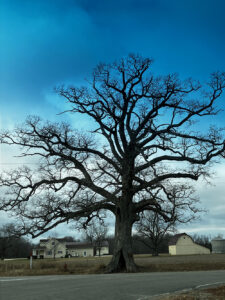There’s a massive, old white oak that stands along a rural highway in southern Peoria County. It is the only big tree within 500 yards of the roadway, yet it is so close to the blacktop that its outstretched branches have been pruned back to make way for traffic. Undoubtedly, this tree stood on this spot for at least 200 years before any roadway was constructed. It is likely that it was standing on this spot before Europeans ever set foot in this region. Perhaps it was along an old buffalo trace that traversed the prairies that was later used as a pathway for human migration. A shady retreat for footsore travelers crossing a sun-soaked prairie on a sweltering summer day. Trees don’t talk, but we often imagine them as sentient witnesses to expanses of time that span well beyond our individual endurance on this earth.
It’s a human trait to seek out hidden wisdom from the “ancients” among us. After all, this tree dates back 10 generations of human existence. It is a survivor. What would this tree say about those generations of humans it has witnessed? I’m not sure we would fully appreciate the wisdom this tree might share with us. On this particular early winter day, I sat by the tree in drenching rain. The view off to the northeast: Open land, stretching to the horizon. Fields covered in corn and soybean stubble greet the falling rain. When this tree was young and hale, tallgrass prairie dominated the landscape. Deep, living roots of the prairie plants would have gratefully accepted the water. Today, the dead roots of a harvested annual crop are oblivious to the gift of H2O from the heavens. Their life is over. There is no need, nor ability, to soak up the rain. The rain gathers in rivulets across the surface of the landscape and runs along the roadside ditch past the tree. The tree drinks its fill, but there is more than its thirst can accommodate. The muddy water carries away nutrients and silt towards Little Lamarsh Creek and onto the Illinois River.
From the vantage point of the tree, two wheeling clouds of birds dance across the landscape. One has the grace of a school of fish on the horizon. European Starlings scour the fields for left-over corn. This species was brought to this country by elite New Yorkers and let loose upon Central Park in 1890. The rationale was that people wanted to provide a new-world home for all birds ever mentioned by William Shakespeare. It is ironic that the Starling reference in “King Henry IV” is of a brainless bird that mindlessly mimics speech. This flock is a relatively new sight for our tree. During its first centuries of its existence, Starling flocks did not dance in the skies. The other flock of birds on the landscape were larger in size and moving in waves. A huge flock comprised of Grackles, Redwing Blackbirds, and Rusty Blackbirds rolled across the empty fields seeking out the same corn that is sustaining the Starlings. Flocks of these blackbirds would have been a life-long memory to our tree. Today, the size of the flocks are likely even larger than when the prairie dominated the landscape. Their numbers bloated by the increased seed biomass provided by modern agriculture. The tree stands silent, but I imagine that it hopes the flock goes on and decides to roost elsewhere.
It is safe to say that the human species has drastically altered the landscape around this old stalwart. These changes have been both intentional and unintentional. Be it the building of a road at its roots, or the introduction of Shakespeare’s birds 1,000 miles away, what we do as a species has ramifications. This tree has had a long and tough life. Several dead branches attest to its struggle for survival. The trunk is hollow, but there is still new growth. If left to its own devises, it could easily outlive several more generations of the human beings. Perhaps the fact that it is still standing says something about an improvement in our environmental ethics. I imagine that whoever maintains the road has contemplated that the tree should be cut down. For whatever reason, it has been left to stand. That is something that both the tree and humanity can be thankful for. It shows that our species can value the wisdom inherent in the ancients among us. In that, there is hope for all species that share this planet.



Recent Comments